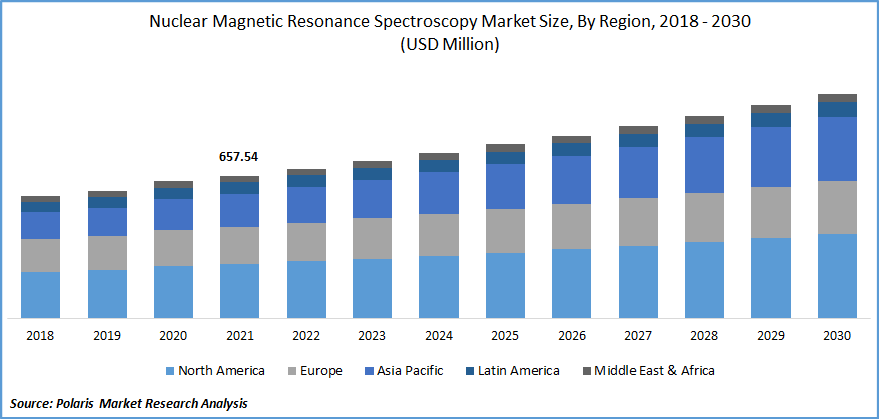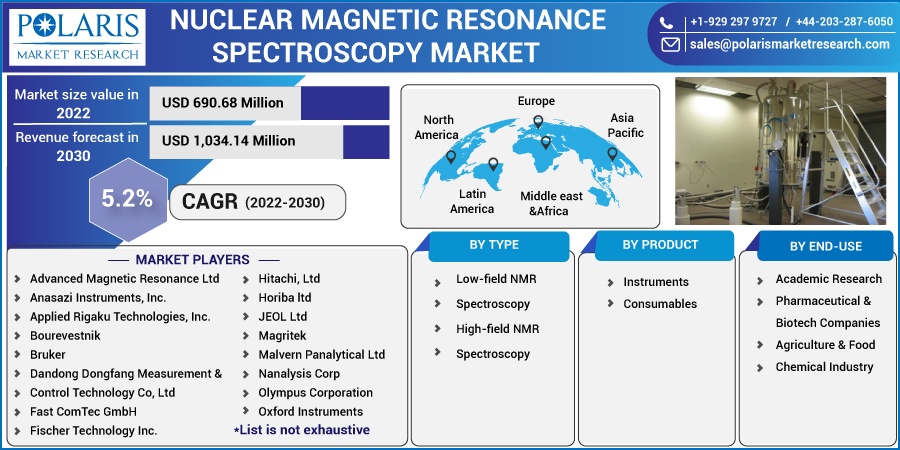
Nuclear Magnetic Resonance Spectroscopy Market Share, Size, Trends, Industry Analysis Report
By Type (Low field, High-field); By Product (Instruments, Consumables); By End-Use; By Region; Segment Forecast, 2022 - 2030
- Published Date:Oct-2022
- Pages: 116
- Format: PDF
- Report ID: PM2673
- Base Year: 2021
- Historical Data: 2018-2020
Report Outlook
The global nuclear magnetic resonance spectroscopy market was valued at USD 657.54 million in 2021 and is expected to grow at a 5.2% CAGR during the forecast period. The growing demand for nuclear magnetic resonance spectroscopy is due to its ability to determine content and test purity in the sample. Furthermore, increasing penetration in chemical and biochemical labs to investigate the characteristics of organic molecules is expected to drive the nuclear magnetic resonance spectroscopy market.

Know more about this report: Request for sample pages
Nuclear magnetic resonance spectroscopy has a wide application in determining DNA and protein structure, hydrogen bonding, solution structure, drug screening, and metabolite analysis, supporting market growth. Penetration in the food industry to understand complex food components and helps to determine the distribution of water, fat, and mobility without damaging the food, which influences the nuclear magnetic resonance spectroscopy market growth.
The rising chronic diseases such as cancer, diabetes, and cardiovascular disorders across developing economies create a lucrative opportunity in pharmaceutical and biotechnological industries to develop drugs. Moreover, the advancement in healthcare technology related to medical imaging, such as CT scans, X-rays, MRI, and ultrasound, is expected to drive market growth.
The COVID-19 pandemic positively impacted the nuclear magnetic resonance spectroscopy market because the NMR instrument detected complex covid-19 macromolecules and analyzed their structure. Furthermore, high-field NMR was in demand to detect the interaction of the covid virus with the vaccine, as metabolic pathways were investigated during the specific stage. Moreover, after the industry resumed, nuclear magnetic resonance spectroscopy was also helpful in diagnosing diseases such as cancer, Parkinson’s disease, and many psychiatric illnesses.
Nuclear magnetic resonance spectroscopy is a versatile technique with low sensitivity that requires a large sample volume to detect the behavior in the compound. Furthermore, the method is time-consuming and operates on expensive instruments, restraining market growth.

Know more about this report: Request for sample pages
Industry Dynamics
Growth Drivers
The demand for nuclear magnetic resonance spectroscopy is expected to be driven by Asia Pacific owing to the growing healthcare sector and demand from various biomedical universities and product manufacturers. The rising infectious diseases such as Parkinson’s disease, malaria, tuberculosis, and cardiovascular illnesses among the geriatric population have created a demand for generic medicines, which has led to drug discovery in the NMR spectroscopy market.
Nuclear magnetic resonance spectroscopy is used in the field of chemical laboratories to measure and generate useful data for environmental monitoring to detect contaminations in soil, air & water, and in food systems, for quality control and research, such factors complement the market growth. Furthermore, demand from several industries, such as biodiesel research, process analytical technology, and polymer research industry, to incorporate NMR spectroscopy to improve the workflow is expected to drive the market.
Report Segmentation
The market is primarily segmented based on type, product, end-use, and region.
|
By Type |
By Product |
By End-Use |
By Region |
|
|
|
|
Know more about this report: Request for sample pages
High-Field Segment Accounted for the Largest Share in 2021
High- field market segment accounted for the highest revenue share in 2021, owing to its improved vulnerability and intent. The high field is growing in demand because of its adoption in many sectors like imaging, biology, and chemical analysis because of its better magnetic field. It has a huge demand in hospitals for advanced research to govern the biology of proteins and their complexes. In addition, the availability of better nuclear resonance in the field of academic research, the oil and gas sector, and food production highlight indicators of particular conditions, such factors driving the demand of the segment.
Low-field nuclear magnetic resonance spectroscopy is also expected to grow in the upcoming years owing to its lower magnetic frequency, resolution, and sensitivity, which detects even tiny changes in the chemical structure of the compound. Furthermore, it has been extensively used in the aquatic product business due to its non-destructive nature and rapid analysis. Moreover, the low-field has wide applications in pharmaceuticals, research, and chemical analysis, which is driving the growth of the segment.
Instrument Segment are Expected to Witness Fastest Growth
Instrument segment to witness the fastest growth owing to their extensive use in medical and research clinics. Furthermore, the growing innovation and development to make instruments that are compact, efficient, and portable and provide accurate results are supporting the growth of the segment. In addition, the advanced high-field NMR, when coupled with database software, aids rapid sample identification, which is expected to drive revenue growth over the forecast period.
Pharmaceutical and Biotechnological Companies is Expected to Lead the Market
Pharmaceutical and biotechnological companies are anticipated to rise in the upcoming years due to their demand in drug development and to determine the composition of drug products, evaluate the impurities and analyze the interaction with the human body. Furthermore, the demand in bioscience to optimize the stability and bioavailability of biological products and stringent government regulations is expected to positively impact the market growth over the forecast period.
Asia Pacific is Expected to Dominate and Witness Fastest Growth Over the Forecast Period
The Asia Pacific is anticipated to witness faster growth over the forecast period owing to the growing biomedical research and raw material availability in the pharmaceutical and biotechnological industry in countries such as China, India, and Japan. In addition, nuclear magnetic resonance spectroscopy has massive demand in the food sector, and a rise in concern about food protection is expected to drive demand over the forecast period. Moreover, the need for biomedical and research activities and the rising demand for environmental safety are factors leading to the market's growth.
Competitive Insight
Some of the major players operating in the global nuclear magnetic resonance spectroscopy market include Advanced Magnetic Resonance Limited, Anasazi Instruments, Inc., Applied Rigaku Technologies, Inc., Bourevestnik, Bruker, Dandong Dongfang Measurement & Control Technology Co, Ltd, Fast ComTec GmbH, Fischer Technology Inc., Hefei Jingpu Sensor Technology Co, Ltd, Hitachi, Ltd,Horiba ltd, JEOL Ltd, Magritek, Malvern Panalytical Ltd, Nanalysis Corp, Olympus Corporation, Oxford Instruments, Spectro Analytical Instruments GmbH, Suzhou Lanscientific co ltd, Thermo Fisher Scientific Inc.
Recent Developments
- In April 2022, Horiba has collaborated with Digital surf to launch a new software range that will allow users to highlight the significant features of samples with the help of electron, probe, and optical microscopy.
- In February 2022, Bruker has launched a new product that could investigate a large protein sample that will be operated with high-field NMR. The new 8mm trosy cryoprobe allows for obtaining accurate responses.
Nuclear Magnetic Resonance Spectroscopy Market Report Scope
|
Report Attributes |
Details |
|
Market size value in 2022 |
USD 690.68 million |
|
Revenue forecast in 2030 |
USD 1,034.14 million |
|
CAGR |
5.2% from 2022 - 2030 |
|
Base year |
2021 |
|
Historical data |
2018 - 2020 |
|
Forecast period |
2022 - 2030 |
|
Quantitative units |
Revenue in USD million and CAGR from 2022 to 2030 |
|
Segments covered |
By Type, By Product, By End-Use, By Region |
|
Regional scope |
North America, Europe, Asia Pacific, Latin America, Middle East & Africa |
|
Key companies |
Advanced Magnetic Resonance Limited, Anasazi Instruments, Inc., Applied Rigaku Technologies, Inc., Bourevestnik, Bruker, Dandong Dongfang Measurement & Control Technology Co, Ltd, Fast ComTec GmbH, Fischer Technology Inc., Hefei Jingpu Sensor Technology Co, Ltd, Hitachi, Ltd,Horiba ltd, JEOL Ltd, Magritek, Malvern Panalytical Ltd, Nanalysis Corp, Olympus Corporation, Oxford Instruments, Spectro Analytical Instruments GmbH, Suzhou Lanscientific co ltd, Thermo Fisher Scientific Inc. |
